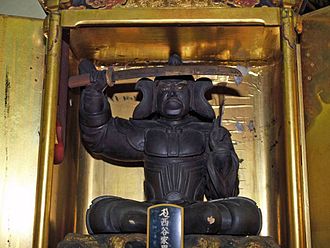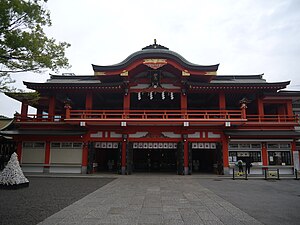Myōken
| Myōken (Sudṛṣṭi) | |
|---|---|
 Statue of Myōken of the 'Nose Myōken' (能勢妙見) type, showing him as a warrior with an upraised sword in his right hand (Hōun-ji, Kami, Hyōgo Prefecture) | |
| Sanskrit | सुदृष्टि (IAST: Sudṛṣṭi) |
| Chinese | (Traditional) 妙見菩薩 (Simplified) 妙见菩萨 (Pinyin: Miàojiàn Púsà) (Traditional) 妙見尊星王 (Simplified) 妙见尊星王 (Pinyin: Miàojiàn Zūnxīng Wáng) |
| Japanese | 妙見菩薩 (Myōken Bosatsu) 尊星王 (Sonjō-Ō / Sonshō-Ō / Sonsei-Ō) 北辰菩薩 (Hokushin Bosatsu) 妙見尊星王 (Myōken Sonjō-Ō) 北辰妙見菩薩 (Hokushin Myōken Bosatsu) |
| Korean | 묘견보살 (RR: Myogyeon Bosal) 존성왕 (RR: Jonseong Bosal) |
| Vietnamese | Diệu Kiến Bồ Tát Tôn Tinh Vương |
| Information | |
| Venerated by | Mahāyāna, Vajrayāna |
| Attributes | sword, tortoise, Big Dipper |
Myōken (Sanskrit: सुदृष्टि, Sudṛṣṭi; Chinese: 妙見菩薩 (Traditional) / 妙见菩萨 (Simplified), pinyin: Miàojiàn Púsà; Japanese: 妙見菩薩, Myōken Bosatsu), also known as Sonjō-Ō (尊星王, "Venerable Star King", also Sonsei-Ō or Sonshō-Ō), is a Buddhist deification of the North Star worshiped mainly in the Shingon, Tendai and Nichiren schools of Japanese Buddhism.[1]
Despite the alleged Sanskrit origin of his name and his bodhisattva status, Myōken is conspicuously absent from early Buddhist literature, with his name first appearing in apocryphal sutras of Chinese origin. He is thus thought to have originated from Taoist and folk beliefs regarding the northern pole star and/or the Big Dipper that had syncretized with Buddhism during the Tang dynasty.[2][3][4] Indeed, despite being called 'bodhisattva' (bosatsu), the deity is actually more often classified as a deva.[5]
The cult of Myōken is believed to have been introduced to Japan around the 7th century by the toraijin, immigrants from the Korean kingdoms of Goguryeo and Baekje, and flourished during the Heian period (794–1185). The eastern half of the country (the modern Kantō and Tōhoku regions), where these immigrants were settled, became a notable stronghold of Myōken worship; the Chiba clan, based on what is now Chiba Prefecture, and its offshoots adopted Myōken as their patron deity and spread his cult through their domains across Japan. Myōken also became an important deity within certain branches of Nichiren Buddhism (such as Nichiren-shū) due to the school's connections with the Chiba.[6]
Origins[edit]

During the Tang dynasty, Chinese Buddhism adopted Taoist Big Dipper worship, borrowing various texts and rituals which were then modified to conform with Buddhist practices and doctrines. The cult of the Big Dipper was eventually absorbed in the cults of various Buddhist divinities, Myōken being one of these.[7]
The earliest source on Myōken is The Divine Spells of the Great Dhāraṇīs Taught by the Seven Buddhas and Eight Bodhisattvas[8] (traditional: 七佛八菩薩所説大陀羅尼神咒經, Pinyin: Qīfó bā púsà suǒshuō dà tuóluóní shénzhòu jīng; T. 1332), purportedly translated some time during the Eastern Jin dynasty (317–420 CE).[7] In the text, Myōken introduces himself as "the bodhisattva of the north star (北辰菩薩) named 'Wondrous Vision' (妙見, pinyin: Miàojiàn, Japanese: Myōken)."[lower-alpha 1]
By the Tang period, esoteric texts and rituals centered on Myōken proliferated; a number of astral mandalas with Myōken as the primary divinity, drawing directly on the Tang texts, have been preserved in Japan. Ennin's diary of his travels in China in 838 suggests that the cult of Myōken was still flourishing there during the late Tang period.[7]
Spread to Japan[edit]

Originally an 11th-century Buddhist temple dedicated to Myōken, converted into a Shinto shrine during the Meiji period
The cult of Myōken is thought to have been brought in Japan during the 7th century by immigrants (toraijin) from Goguryeo and Baekje. During the reign of Emperor Tenji (661–672), the toraijin were resettled in the easternmost parts of the country; as a result, Myōken worship spread throughout the eastern provinces.[9]
By the Heian period, pole star worship had become widespread enough that imperial decrees banned it for the reason that it involved "mingling of men and women," and thus caused ritual impurity. Pole star worship was also forbidden among the inhabitants of the capital and nearby areas when the imperial princess (Saiō) made her way to Ise to begin her service at the shrines. Nevertheless, the cult of the pole star left its mark on imperial rituals such as the emperor's enthronement and the worship of the imperial clan deity at Ise Shrine.[10] Worship of the pole star was also practiced in Onmyōdō, where it was deified as Chintaku Reifujin (鎮宅霊符神).[11]
Myōken worship was particularly prevalent among clans based in eastern Japan (the modern Kantō and Tōhoku regions), with the Kanmu Taira clan (Kanmu Heishi) and their offshoots such as the Chiba and the Sōma clans being among the deity's notable devotees. One legend claims that Taira no Masakado was a devotee of Myōken, who aided him in his military exploits. When Masakado grew proud and arrogant, the deity withdrew his favor and instead aided Masakado's uncle Yoshifumi, the ancestor of the Chiba clan.[12] Owing to his status as the Chiba clan's ujigami (guardian deity), temples and shrines dedicated to Myōken are particularly numerous in former Chiba territories.[13] Myōken worship is also prevalent in many Nichiren-shū Buddhist temples due to the clan's connections with the school's Nakayama lineage.[14]
Veneration of Myōken as a god of war is believed to derive from the practice of worshiping the easternmost star of the Big Dipper, Alkaid (η UMa), known in Chinese as the 'Broken Army' or the 'Destroyer of Armies' (破軍星, Pinyin: Pòjūn xīng; Japanese: Hagunsei) to bring success in battle.[9][15] The Sutra of the Big Dipper for Prolonging Life (北斗七星延命經, Pinyin: Běidǒu qīxīng yánmìng jīng; T. 1307) identifies Alkaid with the buddha Bhaisajyaguru (Yakushi Nyorai),[lower-alpha 2] so that Myōken is thus sometimes considered to be a manifestation of Bhaisajyaguru.[16] In other traditions Myōken was also associated with Kisshōten (Mahāśrī, one of the Seven Lucky Gods).[17] Indeed, some early depictions of Myōken shared similar attributes to those of Kisshōten that a number of what are commonly believed to be depictions of Kisshōten may have originally been Myōken statues.[9]

During the late Edo period, the kokugaku scholar Hirata Atsutane identified the Big Dipper with the primordial deity Amenominakanushi-no-Kami.[18][19] Due to the separation of Buddhism and Shinto, many shrines (and some temples) dedicated to Myōken officially became Amenominakanushi shrines.[9][19]
Iconography[edit]
Depictions of Myōken have varied greatly over time. Aside from representations which conform to standard bodhisattva iconography, Myōken is also portrayed as a youth or as an armored, stern-faced figure holding a sword above his head. He can be shown standing or sitting atop a cloud, a dragon or a tortoise (the symbol of the north in Chinese cosmology). Artistic portrayals of Myōken, particularly those showing him with a sword, are thought to be influenced by depictions of the Taoist deity Xuanwu, who is also venerated as the god of the north.[9][20]
See also[edit]
- Astrotheology
- Big Dipper
- Black Tortoise
- Buddhism in Japan
- Chiba clan
- Chiba Shrine
- Dhruva
- Little Dipper
- Mount Myōken (Tajima)
- Tianhuang Emperor
- Xuanwu (god)
Notes[edit]
References[edit]
- ↑ Brian Bocking (30 September 2005). A Popular Dictionary of Shinto. Routledge. p. 97. ISBN 978-1-135-79739-3. Search this book on

- ↑ Faure, Bernard (2015). The Fluid Pantheon: Gods of Medieval Japan, Volume 1. University of Hawaii Press. pp. 59–60. Search this book on

- ↑ Nakamura, Kyoko Motomuchi (2013). Miraculous Stories from the Japanese Buddhist Tradition: The Nihon Ryoiki of the Monk Kyokai. Routledge. p. 85. ISBN 978-1136792601. Search this book on

- ↑ Shively, Donald H.; McCullough, William H., eds. (1988). The Cambridge History of Japan, Volume 2: Heian Japan. Cambridge University Press. pp. 549–550. ISBN 9780521223539. Search this book on

- ↑ Kodama, Giryū (児玉義隆) (2009). 印と梵字ご利益・功徳事典: 聖なる象徴に表された諸尊の姿と仏の教え. Gakken Publishing. ISBN 9784054041875. Search this book on

- ↑ Faure, Bernard (2015). The Fluid Pantheon: Gods of Medieval Japan, Volume 1. University of Hawaii Press. pp. 71–80. Search this book on

- ↑ 7.0 7.1 7.2 Orzech, Charles; Sørensen, Henrik; Payne, Richard, eds. (2011). Esoteric Buddhism and the Tantras in East Asia. Brill. pp. 238–239. ISBN 978-9004184916. Search this book on

- ↑ Shinohara, Koichi (2014). Spells, Images, and Mandalas: Tracing the Evolution of Esoteric Buddhist Rituals. Columbia University Press. pp. 4–5. ISBN 978-0231537391. Search this book on

- ↑ 9.0 9.1 9.2 9.3 9.4 "妙見菩薩と妙見信仰". 梅松山円泉寺. Retrieved 2019-09-29.
- ↑ Rambelli, Fabio; Teeuwen, Mark, eds. (2003). Buddhas and Kami in Japan, Honji Suijaku as a Combinatory Paradigm. Routledge. pp. 35–36, 164–167. ISBN 978-1134431236. Search this book on

- ↑ Friday, Karl F., ed. (2017). Routledge Handbook of Premodern Japanese History. Taylor & Francis. p. 340. ISBN 9781351692021. Search this book on

- ↑ "千葉神社". 本地垂迹資料便覧 (in 日本語). Retrieved 2019-09-29.
- ↑ "千葉氏と北辰(妙見)信仰". Chiba City Official Website (in 日本語). Retrieved 2019-09-29.
- ↑ "妙見菩薩「開運大野妙見大菩薩」". 日蓮宗 法華道場 光胤山 本光寺 (in 日本語). Retrieved 2019-09-29.
- ↑ Sano, Kenji (佐野賢治) (1994). 星の信仰―妙見・虚空蔵. Keisuisha. p. 9, 237. ISBN 978-4892870965. Search this book on

- ↑ 高橋俊隆. "北辰妙見信仰(北斗・二十八宿)". 日蓮宗 妙覚寺 (in 日本語). Retrieved 2019-09-29.
- ↑ Misaki, Ryōshū (三崎良周) (1992). 密教と神祗思想 (in 日本語). Sōbunsha. pp. 197–198. ISBN 978-4423270127. Search this book on

- ↑ Sasaki, Kiyoshi. "Amenominakanushi no Kami in Late Tokugawa Period". Kokugakuin University. Retrieved 2019-09-29.
- ↑ 19.0 19.1 Mori, Mizue. "Amenominakanushi". Encyclopedia of Shinto. Kokugakuin University. Retrieved 2019-09-29.
- ↑ Schumacher, Mark. "Twenty-Eight Constellations 28 Moon Lodges, 28 Lunar Mansions". A to Z Photo Dictionary of Japanese Buddhist Statues and Shinto Art. Retrieved 2019-09-29.
External links[edit]
| Wikimedia Commons has media related to Myōken. |
